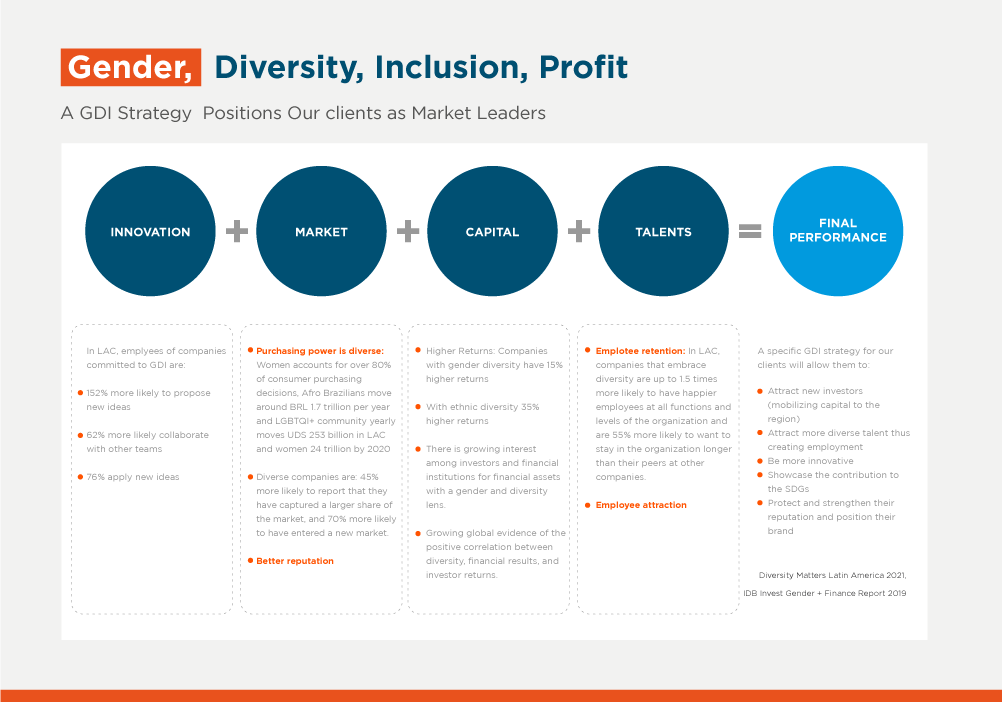Five Steps to Develop an Effective Gender, Diversity & Inclusion Strategy

Although gender, diversity and inclusion (GDI) initiatives are not new for many companies, they usually don’t get implemented for one reason or another. Many companies come up with excellent initiatives but don't have an adequate strategy, or they have the strategy but still lack the initiatives to implement it.
This imposes continuous restrictions on too many companies in Latin America and the Caribbean (LAC), making it difficult for them to compete with others to attract talent, expand in certain markets and optimize profitability. Here are five steps companies can take to make the pieces of their GDI strategy fit together.
1. Help leaders take the lead and see the business case for diversity
No initiative can be implemented without the company’s top management buy-in or their firm conviction about its added value for the business. Lack of confidence, doubts, and uncertainties quickly trickle down from top to bottom. It is essential that managers understand how GDI initiatives can help a given company.
Every company and industry have unique characteristics and can enjoy the advantages that a good GDI strategy can offer. For example, according to studies published years ago, access to credit for women and women-led companies results in shorter arrears terms and increased profits.
In the all-important tourism industry, for example, LAC has many indigenous peoples who are poorly integrated in the sector. By leveraging their knowledge of the local ecology and orography, they could play a key role in many ecotourism strategies, serving as guides and helping to understand better the region's nature.
2. Identify metrics to assess the success of GDI initiatives
Good words do not earn big profits, whereas actions and doing things differently can actually determine a company’s success or failure. When creating a diversity strategy and action plan, businesses need to identify the metrics to assess their GDI initiatives.
As several companies face major challenges to hire women in some traditionally male-dominated industries, setting minimum annual female recruitment targets, for example, can be a way to take decisive and forceful action.
In a recent New Juazeiro bifacial PV project in Brazil, IDB Invest designed a tiered incentive structure that helped the sponsor not only to attain female training and employment goals but also to document the lessons learned, and share them in contractor workshops.
The action plan progress should be assessed on a quarterly basis to make adjustments, if need be.
3. Build governance at company level
One way to ensure that the entire company is involved in the GDI strategy is by creating a diversity and inclusion committee where the key company and industry roles are represented. In addition to experts, an effective diversity committee should be made up of human resources and communication talent and, most importantly, business leaders and top company executives.
In a law firm, for example, there should be a partner on the committee; and, in a logistics company, leading supply chain leaders. This group needs to make sure they review strategies and tailor them to their specific needs, while offering a 360-degree view of the business. Having more diversity entails a cultural company-wide change. The GDI strategy should not become a niche where GDI experts are isolated; otherwise, it might be considered another “Human resources project”.

4. Promote internal training
No cultural change can occur without internal training. The GDI committee decisions should have an impact on the way things are done, and to do so requires that company-wide training reflect the GDI strategies.
All employees need to receive training, from the top management or steering committee to the middle management and the entire organization. It is important that every person within the company understands not only their role and responsibility to create a more inclusive environment, but also the benefits they can derive from it.
5. Communicate why things are done
Internally, communicating the operational benefits of a GDI strategy is valuable and should not be owned by the GDI committee members only. In fact, the information needs to reach all employees, so that they can adapt their way of working accordingly.
Externally, representation counts. Therefore, companies that are committed to diversity should spread the word about their efforts, achievements and lessons learned. While the inclusion challenge is big, all industries can stand to gain a lot by sharing their experiences.
Think about the photographs used in vacancy announcements and product advertisements: they need to mirror the end customer. And this requires true engagement, as the company's reputation is at stake.
A GDI strategy that takes these factors into account will succeed, resulting in a more inclusive and, more importantly, a more profitable company that engages potential customers.
As women and minority groups are often customers as well, their professional involvement in projects can help create more successful projects with a greater impact. Believe me: women, indigenous people and LGBT individuals also need credit lines, enjoy traveling and consume energy.

LIKE WHAT YOU JUST READ?
Subscribe to our mailing list to stay informed on the latest IDB Invest news, blog posts, upcoming events, and to learn more about specific areas of interest.
Subscribe



